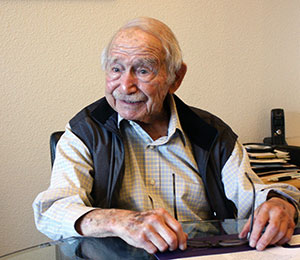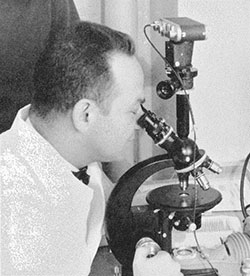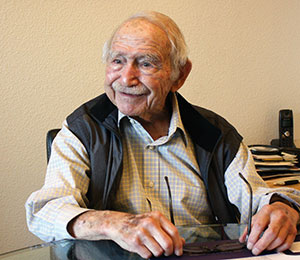Former director, UW Center for Research in Oral Biology
 Dr. Leo M. Sreebny, 97, a native of the Bronx, New York, received his dental education during World War II in the Army Specialized Training Program. He earned his DDS in 1945, a master’s degree in pharmacology in 1950 and a PhD in pathology in 1954 from the University of Illinois. In 1957, Dean Maurice “Jack” Hickey recruited Dr. Sreebny to our School to establish a Department of Oral Pathology and to encourage research in the basic sciences relevant to modern dental treatment. Dr. Sreebny also held a joint appointment in the Department of Pathology of the UW School of Medicine.
Dr. Leo M. Sreebny, 97, a native of the Bronx, New York, received his dental education during World War II in the Army Specialized Training Program. He earned his DDS in 1945, a master’s degree in pharmacology in 1950 and a PhD in pathology in 1954 from the University of Illinois. In 1957, Dean Maurice “Jack” Hickey recruited Dr. Sreebny to our School to establish a Department of Oral Pathology and to encourage research in the basic sciences relevant to modern dental treatment. Dr. Sreebny also held a joint appointment in the Department of Pathology of the UW School of Medicine.
Soon after his arrival, he established a Clinical Pathology Lab to assist dentists and physicians with the diagnosis, treatment, and prevention of oral diseases. Additionally, he developed a curriculum for the teaching of oral histology and oral pathology. He also established a graduate program leading to an MS in oral pathology.
In 1961, as a reflection of the expansion of the department, an increase in its teaching responsibilities and the greater diversification of its research, the Oral Pathology Department changed its name to the Department of Oral Biology. During this time, it received authorization from the UW to offer a PhD degree in oral biology. It was the second dental school in the United Sates to receive such permission. In 2007, after 50 years as a separate department, the Department of Oral Biology was incorporated into the Department of Oral Health Sciences.
In 1967, Dr. Sreebny was awarded a grant from the National Institute of Dental Research to establish a regional dental research center, which was named the Center for Research in Oral Biology. It was one of only four regional dental centers in the United States and the only one on the West Coast. He served as the Center’s director until 1975, when he left to become Dean of the School of Dental Medicine at the State University of New York at Stony Brook.
Dr. Sreebny’s early research focused on the effects of hormones and the physical consistency of foods on the salivary system. After 1975, his focus became the relationship between drugs, dry mouth and Sjogren’s Syndrome, an autoimmune condition wherein the prime symptoms are dry eyes and xerostomia. During his tenure at the UW, he was Chairman of the Dental Study Section at the National Institutes of Health (1967), a Fellow of the American Association for the Advancement of Science (1970), and a member of the Committee on Science Policy at the National Academy of Sciences (1973-1974). In addition, he was one of the founders of a new discipline in dentistry: oral biology.
At the international level, he was a Fulbright Scholar and lecturer at the Hebrew University in Jerusalem, a visiting scientist with the World Health Organization, a visiting professor at Witwatersrand University in South Africa, and was elected to the List of Honor by the International Dental Federation, where he served 18 years as head of its scientific program group. In 2001 he was awarded an honorary doctoral degree from Semmelweis University in Budapest, Hungary for his contributions to dental science.

Coming to Seattle: It was 1955. So, what was a 35-year-old “kid” from the “Da Bronx” doing in Seattle? So I’ll tell you. I was turning down an offer to become a member of faculty of the Department of Periodontics and Endodontics at the University of Washington. That’s what I was doing. It was like this.
At that time, I was happily ensconced as an Associate Professor at the University of Illinois, teaching oral pathology and periodontics. In the fall of that year, I received a call from John Ingle, Professor and Chairman of the Department of Endodontics and Periodontics at the UW. They were looking for an oral pathologist, and I had the credentials and the background that appealed to them. Would I consider coming to Seattle and visiting the University? As I recall, I said, “Where, Seattle?” But, of course, I acquiesced to go.
I had never been west of the Mississippi River. I took my baccalaureate degree at the City College of New York and the University of Illinois in Urbana (1939-1942). I then attended the dental school at the University of Illinois Medical Center in Chicago (1942-1945). While there, I was a member of the U.S. Army Specialized Training Corps. The war in Europe ended in April 1945 and the Army said they had no further need for dentists. So they discontinued the ASTC program. Following my discharge from the Army, I became a resident in dentistry at the University of Illinois Teaching and Education Hospital.
During this period, I also applied for admission to the U.S. Navy. I was appointed as a lieutenant junior grade in the Dental Corps and served for two years with the 3rd Marine Division on the island of Guam. Upon my return home I rejoined the faculty of the School of Dentistry at the University of Illinois to engage in teaching, research, and further education. I received an MS in pharmacology (Materia Medica) in 1949 and in 1954 I was awarded a PhD in pathology. I believe I was the first dentist in the United States to receive a doctorate in medical pathology. My research was devoted to the biology of the salivary glands in health and disease.
So why was I rejecting an offer from the UW to become a member of the Department of Periodontics and Endodontics? Because I thought that the dental school should recognize the importance of oral pathology and create a separate department at the University. But I was really impressed with the dental school and fell in love with Seattle. However, I sadly informed my family that we would not be moving to the Northwest. How wrong I was.
In 1956, the dental school appointed a new Dean, Dr. Maurice “Jack” Hickey, from Columbia University. Dean Hickey was trained both as a dentist and as a physician. During the Second World War he served as an oral surgeon with the U.S. Army in Europe. He was cognizant of the significant role that a separate Department of Oral Pathology would make in the school and asked Dr. Ingle to again invite me to visit the university.
I was thrilled. The following year, I was offered and gladly accepted an appointment as a Professor of Oral Pathology and the Chairman of a new department. The responsibilities of the department were to teach oral pathology and oral histology, to provide a biopsy service and to encourage research in the basic sciences relevant to modern dental treatment. I also was appointed as a Professor of Pathology in the medical school.
Recruitment to the School: Before I accepted a position, my wife, Mickey, had to visit Seattle. During our visit in November John Ingle invited us to lunch, and he picked us up at the Meany Hotel, where we were staying. He drove and drove, across a bridge to an island and across another bridge, and I said, “John, where the hell are we going?” He said, “You’ll see when we get there.” As we continued the drive, it started to snow. Moreover, we observed that there was snow all around us.
We finally got to a place called Snoqualmie. We arrived and Mickey asked, “Where are we going to eat?” John responded, pointing upward, “On top.” We had to get on a ski lift! I’d been on a ski lift once in my life. Mickey had never been on one and was wearing open-toed shoes. John said, “Leo, you go with Mickey, and I’ll stay behind you.” So, I put Mickey on the ski lift and before I could get on, the lift moved, and it kept moving. There she was all alone, and I’m back with John. She’s screaming, “Get me outta here! Get me outta here!” And I’m screaming, “Oh God, this is beautiful! I’ve never seen anything as beautiful as this!” We arrived at the top to find that the restaurant was closed.
I accepted the job! And Mickey loved it here, she really loved it.
Dean Hickey: Jack Hickey was the most liberal and far-reaching dean, with a huge imagination about what a dental school should be. He came to Washington in 1956. It was incredible to work for him, and he was just a nice human being. If you came to him and you put up a case, he rarely said no, and he usually offered to help. Now, that’s an unusual dean.
Colleagues: John Ingle was a remarkable department head. Both he and his wife, Joyce, became our dear friends. Ken Morrison was the superb Chairman of the Department of Restorative Dentistry. Alton Moore was the founder and distinguished Chairman of the Department of Orthodontics. I first met Al when he and I were both at the University of Illinois School of Dentistry. Sam Dworkin brought another dimension to the School. He was involved with clinical testing and with public health, and that was a great development in the School.
And then there was Saul Schluger, the distinguished periodontist — and the school character. He was a quintessential New Yorker. He never got over his ties, both clinical and emotional, to New York City. He was a remarkable storyteller. He told a story about a debate that he and a colleague and friend, who shall remain nameless, once had. They violently disagreed about some – I thought insignificant – matter relating to the periodontium. At one point in this argument, Saul threw a piece of chalk at his colleague and said, “You know, when they circumcised you, they threw the wrong piece away.”
Establishing a new department: I was a bit scared, having never done this in my life, but I was very excited. I was given an office and labs in the basement of the building. The first man I hired was George Yamani, an oral pathologist who was board-certified and could do all the work with the biopsies from the School. George was the first person of Asian descent (Japanese) on the School faculty. I also hired Cyril Enwonwu, a dentist and a superb biochemist with a degree in nutritional biochemistry and metabolism from the Massachusetts Institute of Technology. His primary interest was in protein-calorie malnutrition. Dr. Enwonwu was an Igbo from the Biafran state of Nigeria. He was here on a visa when the civil war broke out between Biafra and the Nigerian government in 1967. The Nigerian government was trying to get him back. So, I sought advice and help from Washington’s Senator Henry Jackson. I was later advised that he introduced, and the Senate passed, a bill to make Dr. Enwonwu a citizen of the United States.
At varying times, other distinguished members of the Department included Pat Keller, a biochemist; Ivens Siegel and Ken Izutsu, pharmacologists; Arnold Tamarin, a histologist; Russell Ross, a pathologist; Dorthea Johnson, an oral biologist; Murray Robinovitch, a periodontist; and Robert Redman, a pathologist.
Then I had to hire an administrative assistant. I’d never interviewed anybody for a job like that. A number of people came in who weren’t qualified. Then this lady, Darleen Treneer, came in and she seemed OK. I asked her, “Do you take shorthand?” She said, “Where have you been? You’re so outdated! You can speak into a microphone and I can record it.” So, I hired her and she was incredible. She worked for me for about 10 or 12 years, and then she worked for the Dean of the medical school, John Hogness. When Dr. Hogness became the president of the University, she became his assistant and advisor. She was fabulous. Darlene, in turn, hired Sharon Lakefish, a superb organizer and supervisor of the varied technical aspects of the department’s secretarial activities.
Establishing the Center for Research in Oral Biology (CROB): In the mid-’50s, the Health Sciences division of the UW was an exciting place to work, because many of its academic departments were being established and developed. There was, however, no hospital and there were only a few research centers. Most of the discussions in the division were focused on the development of the University Hospital. At about the same time, in Bethesda, Maryland, the National Institute for Dental Research (NIDR) was promoting the formation of regional dental research centers. Centers were being considered at the Universities of Michigan, Pennsylvania, Alabama, and North Carolina. I wondered, could we establish a regional center at the University of Washington?
 I consulted with a lot of people on campus: in the dental school, the clinical and basic sciences of the medical school, the College of Engineering, even the School of Fisheries, just to see if I could whip up some enthusiasm to work with projects and diseases that had or could have relevance to oral problems. The response was incredible. People here were quite receptive to this concept. So I decided to apply for such a grant.
I consulted with a lot of people on campus: in the dental school, the clinical and basic sciences of the medical school, the College of Engineering, even the School of Fisheries, just to see if I could whip up some enthusiasm to work with projects and diseases that had or could have relevance to oral problems. The response was incredible. People here were quite receptive to this concept. So I decided to apply for such a grant.
In my application, I said, “Look, I’ve never done this before, and I have no idea if it will work, but these are the interests expressed to me, and I really think we can do this.” I listed people and their proposed projects in the various schools of the health sciences and in several schools outside the health sciences. Representatives of the NIDR came and visited the University and interviewed all the members of the faculty listed in my grant application. I was shocked when we got the award. It was an amazing and wondrous experience!
I was an idea man, and it was my image that – fortunately or unfortunately – the Center reflected. Dr. Dan Middaugh, on the other hand, was a detail genius. I recruited him to be the assistant director of CROB. You gave him anything to do, he came up with the specifics and was excellent at it. He was the Editor of the Center’s monthly publication.
The Center for Oral Biology, like other Centers in the UW Health Sciences Center, expanded the research capabilities of the school they were affiliated with and provided opportunities for students to pursue advanced degrees. They also increased the public awareness and understanding of their respective missions. For example, the CROB was particularly involved with Seattle’s development of a policy regarding the fluoridation of its water supply.
The Center also sponsored the first international conference on the salivary glands and their secretions. Scientists from every continent in the world attended this meeting. Dean Hickey opened the conference by welcoming the participants to the University. “Note,” he said, “I welcome you to the University, rather than to the School of Dentistry. By so doing, I express my belief in a concept of research that is more concerned with human biology than with any specific discipline or disease. … While we admit the value of research aimed at the cure and prevention of oral disease, we must ensure the freedom of research workers to follow their own intellectual interests. Dentistry is bound to profit from this in the long run.”
When Dr. Sreebny resigned from the UW in 1975 to become the Dean of the School of Dentistry at Stony Brook University in New York, the CROB remained in Seattle.
Crustacean emanation: I was driving back from a meeting at the University of British Columbia, and I stopped off and bought a 50-pound sack of oysters and brought them into the department. Our labs were in the basement, we cooked them in a hood that was in the lab and had a festive meal of oysters and crackers. About 15 minutes after we put them in the hood, we got this frantic call from the main clinic upstairs: “What kind of foul chemicals are you working with down there? Stop it! It’s stinking up the place.” The hood was directly connected to the main clinic!